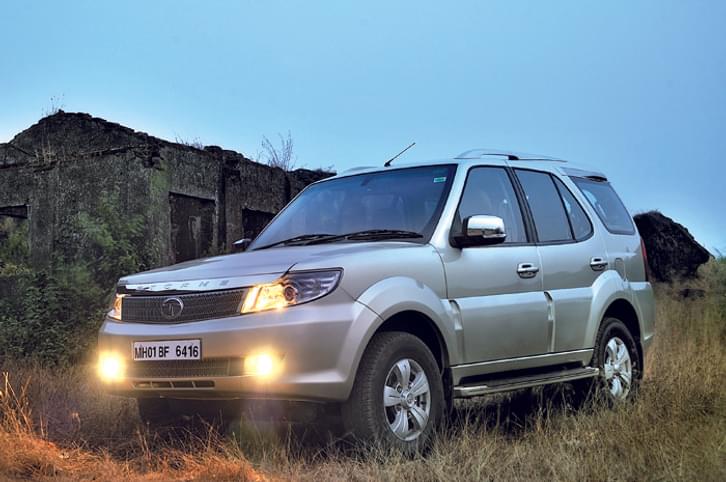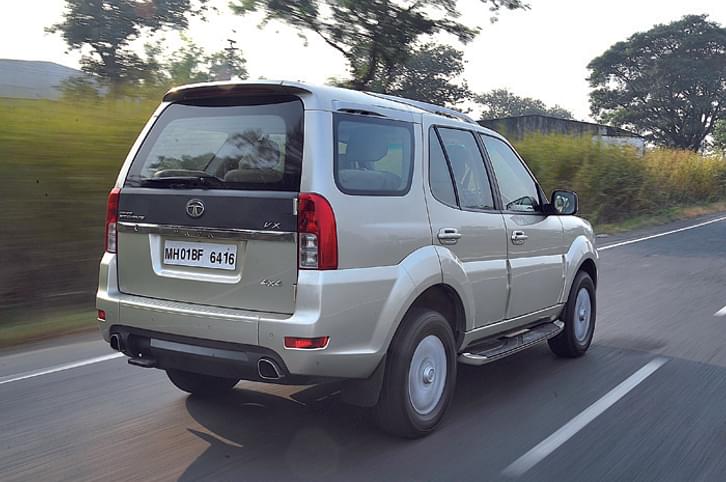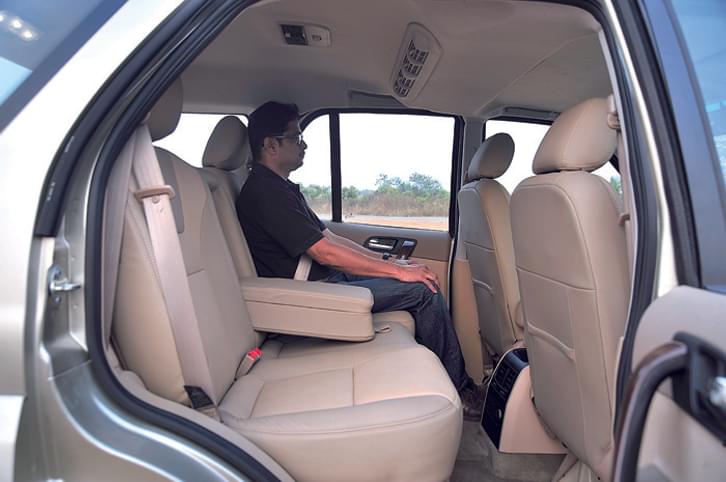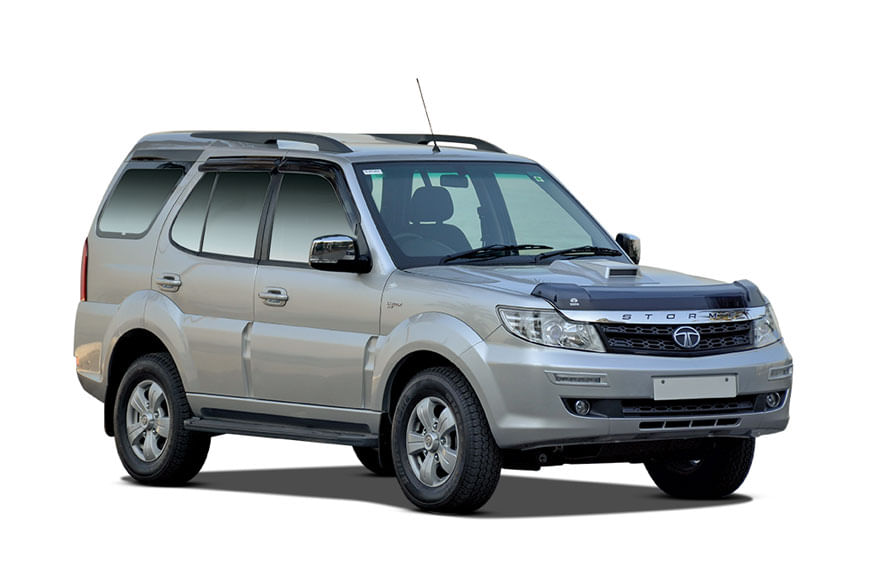Tata Safari Storme review, test drive
Tata has drafted in a successor to the Safari after 14 long years. But is it good enough to revive the carmaker's fortunes in the SUV segment?
Updated on Jun 04, 2015 12:38:52 PM
15,787 Views
Follow us on


New dash design looks modern and quality has taken a big leap over the old car.

The car you see here is the new Safari Storme. It looks like a facelift, but underneath, it is completely different from its predecessor. This is both a good thing and a bad thing, as you will soon see. Built on Tata’s hydroformed body-on-frame X2 platform, the Safari promises to be a whole lot better to drive and a lot more refined too. Prices start at Rs 9.9 lakh for the base 4x2 and go on to Rs 13.7 lakh for this top-end 4x4 VX. Question is, do the new underpinnings help the Safari take the big leap into the present?
Unlike the old car, which was based on the 1988 Tata Mobile platform, the Safari Storme is built on Tata’s relatively modern X2 platform, which also underpins the Aria. The chassis is nearly 50 percent stiffer and about 35kg lighter than the old Safari’s outdated frame. Overall, the Safari is 75kg lighter than before, but at 2095kg for this 4x4, it’s still really heavy. Apart from the frame, another big change is the Safari’s suspension. The earlier car’s front torsion bar layout has made way for wishbones with coil springs to leave space for front driveshafts. The rear suspension is similar to the old car’s five-link design, but the front and rear tracks are now wider to aid stability. To add to safety, the Safari will sell with rear disc brakes as standard.
The original Safari’s large windscreen, stepped roof and tall stance are all there, and the styling changes at the front, side and rear just don’t look substantial enough. That said, the wide mesh grille and the chrome bar that cuts into the headlights do help to give the Storme a slightly different identity. New plastic cladding and larger wheel arches help too, but perhaps it’s the redesigned tail that best distinguishes the new Safari from the earlier model. The big change here is the repositioning of the spare wheel from the tailgate to under the body. This means less weight on the tailgate, and Tata engineers claim this has also served to rectify the rattling issue that was a bugbear on earlier Safaris. The fat chrome strip that runs across the width of the tailgate adds some flash here, while the twin chrome exhausts and grey plastic scuff plate look neat too.
| Tata Safari Storme Price, Mileage, Specifications, Features and Variants | |
|---|---|
| Brand | Tata |
| Model Name | Safari Storme |
| Tata Safari Storme Price | NA |
| Tata Safari Storme Range/Mileage | Diesel : 13.9 - 14.1kpl |
| Tata Safari Storme Specifications | SUV | 5 doors | 7 seats View All Specs |
| Tata Safari Storme Features | Halogen headlight | 3.9-inch Screen display | 0 airbags View All Features |
| Tata Safari Storme Variants | 2.2 Varicor 320 LX 4X2 | 2.2 Varicor 320 EX 4X2 | 2.2 Varicor 400 VX 4X2 View All Variants |
On the inside, the dashboard is totally redesigned and, while not unique, it is pleasing to look at. But more than anything, it’s the Safari’s improved quality that gets your attention. Right from the soft-touch plastics on the dashboard to the chrome detailing on the door handles and gear lever, everything plays a part to make the cabin far more upmarket than before. It also feels far better put together, though it’s still too early to pass judgement on long-term durability. However, the interior is still not perfect. Bits like the power window switches, air-con controls, and the seat height and steering adjusters are still not up to scratch. Even the aftermarket single-DIN music system looks out of place in this day and age, where integrated two-DIN music systems are more or less the norm. But when you compare it to the other home-grown SUVs, the Storme’s cabin is still the best built.
What you will unquestionably like the Safari for is its space. The large windows allow plenty of light to enter the cabin but, surprisingly, the front seats aren’t as comfortable as before. They are rather flat, offer a bit too much thigh support, and there is an excess of lower back support. The seatback is too firm as well. Still, front-seat height and steering rake adjustment help make finding the ideal driving position easy, and general ergonomics are good too. Middle-row passengers will like the seat for its sofa-like comfort. It’s wide enough to seat three and there’s enough support for your thighs as well. In stark contrast, the third row is far from comfortable or practical. The tiny, foldable jump seats are only usable on short journeys at best. With them folded, you can make space for luggage, but if you need to travel heavy, you can fold the middle row forward too.
Equipment-wise, the Storme is a bit of a mixed bag. You get all the essential features, but some helpful features like a reversing camera (which was offered on the earlier Safari) are missing.
The Storme gets the same longitudinally mounted 2.2-litre, 138bhp DiCor motor (which Tata has now dubbed ‘VariCor’) as in the old Safari. It gets the G76 Mark II gearbox, with improvements to the gearshift action. The minute you fire up the engine, you know that lots of work has gone into making the powertrain better. It’s significantly smoother than before, courtesy an inertia flywheel that damps vibrations. Good sound deadening also helps maintain relatively low engine noise levels in the cabin.
Unlike most turbo-diesels that are peaky and have a narrow rev band, this VariCor unit has nice and linear power delivery and can rev happily to 4600rpm. It does get quite vocal past 3000rpm, so you’re best off shifting earlier in the rev range. What’s nice is that there’s not much turbo lag to worry about, so you don’t always feel the need to shift down when revs go south of 2000rpm. While that makes the Storme quite easy in traffic, it’s on the highway where the Safari Storme can stretch its legs and come into its own. The punchy mid-range makes overtaking effortless and it can be deceptively quick (by traditional SUV standards) on open roads.
Flat-out acceleration is quite impressive, and 100kph comes up in 14.9 seconds, putting the Stome
on par with most of its rivals. The clutch is quite light and the gearshift has been improved too – it has a nice, short throw, it feels accurate, but isn’t exactly slick, and it still needs an extra bit of a push.
The biggest step up over the old car is the way the Safari behaves on the road. It’s genuinely among the best-riding SUVs we’ve driven. The combination of its pliant, tall springs and stiff chassis delivers a ride quality that is so absorbent and silent, it gives you the confidence to drive over ruts and potholes without scaling back the pace much.
The slow steering offers very little feedback, the body rolls quite a bit, and it simply doesn’t feel agile. Even in the city, the Storme isn’t the most nimble SUV to drive. You always feel its girth and the slow steering, combined with the large turning circle, is not the most ideal for tackling heavy traffic. What does help, though, is that the traditional Safari strengths of a low window line, the big windscreen and the high seats give you a bird’s eye view out.
Off the road, the Storme gets all the four-wheel-drive hardware (low ratios, limited-slip differential) you need to tackle the toughest of terrain.
The Storme betters the old Safari on fuel efficiency. It gave us 10.1kpl in the city and 13.2kpl on the highway against the old one’s 8.7kpl and 13.1kpl, respectively. We put these improvements down to the Storme’s 35kg lighter kerb weight. That said, the highway figure should have been better as the Storme’s gearing is taller than the old car’s. But remember, its aerodynamic properties are still similar to the old car’s.
Copyright (c) Autocar India. All rights reserved.



Comments
Member Login
Personal Details
No comments yet. Be the first to comment.